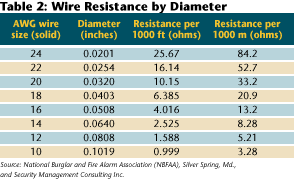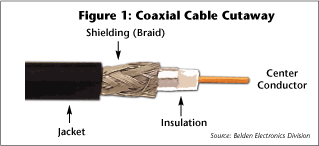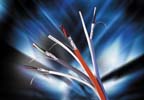Wired to Buy

Installing cable can be some of the hardest work on a job, so that is why security dealers and systems integrators must select their cable carefully to ensure from the start that the one chosen is right for the job. Security wiring has an alphanumeric code to indicate where it should be used.
Examples of these designators, which are defined in the National Electrical Code (NEC), include CMR, FPLP and others (see Table 1). Codes beginning with “CM†designate communications cable used for alarm, video surveillance or access control systems. Cables with codes beginning with the letters “FPL†are more resistant to fire and are intended for use in fire systems.
Cables ending in “G,†such as CMG or FPLG, are intended for general use, which means they should not be installed in risers that connect one floor to another or in plenums. The latter refers to a compartment or chamber to which one or more air ducts are connected that forms part of an air distribution system.
Cables with an “R†on the end, such as CMR and FPLR, are suitable for use in riser installations. Those for use in plenums have a “P†on the end. These letters designate that the cable has been manufactured to pass certain tests. Those tests are designed to help ensure, for example, that cables installed in plenums do not generate excessive toxic fumes or molten material if they catch on fire.
Another important factor to consider when purchasing any cable is whether it will be installed outdoors or buried underground, in which case the installer should take care to select a cable with a heavier jacket that is designed for that purpose.
Installers also should consider whether the cable will be visible to the end user, and if so, whether it needs to be a certain color to blend in with a customer’s décor or with cable already installed in the same location.
Outer diameter tolerances also can be important, notes Jeff Slater, director of sales and marketing for electronic products for General Cable. If a cable is manufactured to tight tolerances, the diameter across the length of the cable should vary little. “There’s nothing a contractor dislikes more than pulling a cable and then finding that the connector doesn’t fit,†Slater points out.

Alarm, Fire and Access Control
Intrusion protection, access control and fire systems typically use two-conductor or four-conductor copper wire surrounded by a layer of insulation and encased in a protective jacket made out of a plastic compound. Video surveillance systems typically use RG-59 or RG-6 coaxial cable.Although the copper wire used for intrusion protection, access control and fire systems may look similar, several variables are involved. One of these is the wire’s gauge or diameter, which is indicated by the first of two sets of numbers separated by a slash that are used to designate each wire type. For example, in the designation 22/2, the number 22 indicates the wire gauge.
In the United States, wire gauge is specified according to the American wire gauge (AWG) system, in which lower numbers indicate wider diameters of wire (see Table 2). Because wider-diameter wires conduct or carry a signal better, they provide a stronger signal over a greater distance than wires with narrower diameters. Installers should check the manufacturer’s specifications for the security devices they are connecting to determine the gauge of wire that is suitable, which may depend on the distance of the wire run.
The number after the slash in the wire numbering system indicates the number of wires that a cable includes. In the example above, the “2†that comes after the slash indicates a two-conductor cable.
Some equipment manufacturers specify a particular cable manufacturer’s part number for use with their products. Although other cable manufacturers may say their products are equivalent, installers should take care before making a substitution.
As principal and senior consultant for All County Security, Putnam Valley, N.Y., Joseph Hayes writes, installation specifications for engineering and architectural firms when security or fire protection is part of a construction job. If an equipment vendor calls for a particular manufacturer’s part number for cabling, that is the cabling that Hayes specifies.
“I will accept an ‘or equal’ wire,†notes Hayes, who also is a senior instructor for the National Training School (NTS) of the National Burglar and Fire Alarm Association (NBFAA), Silver Spring, Md. “But I require the contractor to prove the ‘or equal.’â€
Proving that another cable provides identical performance necessitates including technical performance reports on that cable, such as signal loss; crosstalk, or interference between wires; and resistance to radio frequency or electromagnetic interference.
When purchasing wire for burglary, fire or access control systems, dealers also should consider the type of insulation used, advises Steve Sterling, product manager for Honeywell Genesis series cable.
PVC used for the jacket and the insulation may have a tendency to stick to itself and make the cable difficult to strip, he maintains. Polypropylene may be a better alternative for the insulation because it will not stick so easily to the PVC jacket, he advises.

Coaxial Cable
The coaxial cable used for video surveillance systems has a distinctly different design than the copper wiring used for other security applications. The coaxial cable used for video surveillance has a narrow metallic center conductor surrounded by a layer of insulation known as the dielectric, which is wrapped with a braided copper shielding (see Figure 1). Surrounding the copper braid is an outer jacket made from a plastic compound.Although video surveillance wiring looks similar to the wires used to connect cable television, their composition is different and the two should never be substituted for one another, cautions Sterling. “The big difference between the two is that CCTV is very low frequency and CATV, or cable television, is very high frequency,†explains Sterling.
Although high frequency signals will have a tendency to fan out and ride the outer part of the conductor, low frequency signals will tend to ride the center of the conductor. For cable television, a center conductor made of copper-covered steel will give the best performance, but for CCTV systems, a pure copper conductor should be used.
The differences between CCTV and cable television also dictate different shielding choices. Although the coax for cable television works best with a solid shield, the best shielding for video surveillance applications is bare copper braid with 95-percent coverage, Sterling explains.
Shielding is one area where some manufacturers may skimp, cautions Carl Fedders, product manager for electronic products for Coleman Cable. “Some claim 95-percent braid, but they’re really 88-89 percent, which can affect performance,†Fedders asserts. “We tell dealers if they see a price that seems too good to be true, send a sample to us. Nine times out of 10, it’s not what it claims.â€
The material used for the dielectric insulation is also important, notes Kirk Horlbeck, senior vice president for corporate marketing for Liberty Wire and Cable. He prefers a gas-injected dielectric. This provides evenly spaced pockets of gas in the foam insulator, which helps keep a consistent distance between the center conductor and the copper braiding.

PHOTO COURTESY OF BELDEN CABLE
Packaging
It always is a good idea to consider ease of installation when purchasing security system cabling, and manufacturers have devised a number of packaging enhancements that can help with this. For example, using cable with a rip cord can simplify termination.Some manufacturers also make composite or Siamese cables, which include wires of more than one gauge, or may combine a coaxial cable with, for example, two-conductor copper wire. These can save installation time when connecting multiple devices between the same two locations, because installers only have to pull a single cable.
“On access control installations, most systems require four cables to be pulled to one door – door contact, request exit, card reader and lock power,†notes Juan Gudino, market manager for low-voltage security products for Belden CDT. “Imagine the added cost of pulling four cables, labeling them and then connecting them at each door.
“But if you could pull one cable that groups the four applications using a banana peel design, you can reduce installation time around 30 percent and avoid troubleshooting and installation problems when running individual cables,†he points out.
Composite cables, which have an outer jacket surrounding multiple inner jackets, may be preferable to Siamese cables, which use a single jacket, notes Horlbeck. The extra jacketing on the composite cables makes them more rugged, he maintains.
Cabling that includes foot markers is another nice option, notes Abbott. “You know how much you’ve used and how much is available for the next place you’re going,†he declares.
Another option to consider is wires with jackets in several different colors or with stripes in a variety of colors. Initial Electronics, Alsip, Ill., makes a point of ordering different types of cable in different colored stripes, notes Toni Mastro, purchasing manager for the company. Technicians can tell easily which cable to use for each application, “and if we need to go back to a customer site for any changes or add-ons, we can identify our cable,†Mastro notes.
Before ordering too many different types of cable, security dealers should consider whether a single cable can be used for multiple purposes, advises Sterling. For example, he notes that any Genesis cable that meets NEC requirements for communications cabling (the CM designation) also can meet requirements for Class 2 or Class 3 circuits. Because the CM cable is no more costly than a typical Class 2- or Class 3-rated cable, it may be unnecessary to stock any communication cables other than those with the CM rating, Sterling maintains.
Another way of minimizing stock-keeping units (SKUs) is to standardize on just a few wire gauges, even if that occasionally means using a heavier gauge of wire than is required for some jobs. Using a heavier gauge wire also can help to future-proof an installation. “A lot of customers go back to the end user and increase the after-market sale by adding motions, gate controls and viewing cameras,†notes Horlbeck. “And as devices become lower in cost and higher in function, they may require higher-gauge wire.â€
When possible, purchasing agents also should consider buying for more than one project at a time, enabling them to take advantage of volume discounts. Although storage can be a concern, some manufacturers or distributors will deliver to a job site.
Sidebar: Circuit Integrity Cables
Security dealers soon may need to add another acronym to their cable lexicon, if they have not already. The latest version of the National Electrical Code (NEC) includes a new type of cable designated with the letters CI for circuit integrity.CI cables are intended for use in high-rise and other buildings equipped with emergency warning or life safety evacuation systems. Such cables must pass tests to demonstrate that they can help ensure the continued operation of emergency warning systems for at least two hours in the event of a fire.
Some states have not yet mandated adherence to the latest version of the NEC, notes Juan Gudino, market manager for low-voltage security products for Belden CDT. But it is only a matter of time before CI-rated cables come into use nationwide, he predicts.
Sidebar: Zero Halogen on the Horizon?
In recent years, some people have become increasingly concerned about the material used for the jackets on security and electrical cables, particularly in the event of a fire.“When PVC burns, it puts out heavy smoke, corrosive gases and hazardous fumes,†explains Kirk Horlbeck, senior vice president of corporate marketing for Liberty Wire and Cable. Some critics also claim that PVC could have a potentially hazardous long-term effect on the people who frequently install it, and that if installed underground, it could leach into the ground water.
Requiring low-smoke jacket material for plenum installations was the first step in addressing PVC concerns, Horlbeck relates. The next step would be to use halogen-free jacket material, he notes.
Although PVC concerns have not yet had much impact on the mainstream security industry in the United States, that could change, especially now that regulators in Europe have begun to mandate the use of halogen-free jacketing for security and other applications. Domestically, policy makers in Oregon and California are considering the passage of similar legislation, Horlbeck reports.
One area where PVC concerns already have made an impact in North America is in yacht outfitting. Lloyd’s of London is expected to require zero-halogen cabling for any yacht that it insures, notes Dave Agostine, CEO of Intelect Integrated Electronics, Fort Lauderdale, Fla., a company that specializes in equipping yachts.
“We won’t wire a boat with anything except that wire,†Agostine promises, adding that Intelect’s work often includes security systems. “The qualities that wire provides include low or no smoke and the ability to somewhat self-extinguish.â€
Those qualities are particularly important in the confined spaces onboard a yacht, he points out. “The whole idea is to make the boat as safe as possible,†Agostine explains.
Security companies should consider offering zero-halogen cabling to traditional customers as well, advises Horlbeck. “The savvy dealer isn’t buying cable, he’s selling it,†Horlbeck maintains.
Although zero-halogen cable is more expensive than conventional cable, Horlbeck thinks it may appeal to certain customers, particularly in areas where legislation is pending and using zero-halogen cable could add to a home’s resale value.
“Some dealers use a good, better, best approach with cable,†Horlbeck notes. “It can give them a professional edge as a knowledge broker.â€
Some manufacturers, including Liberty and Belden CDT, have begun to manufacture zero-halogen cable, which they sell primarily in Europe. “Here in the U.S., we’ve seen it used in subways and data centers,†notes Juan Gudino, Belden’s market manager for low-voltage security products.
Looking for a reprint of this article?
From high-res PDFs to custom plaques, order your copy today!


